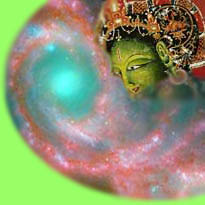|
The Short Commentary on the Tantra of Twenty-one Homages to Tārā called “The Treasure Vase of by Thupten Shedrub Gyatso. |
The Unchallenged Furious Lady |
|||||||||||||||||||||
|
7
|
namas traḍ-iti-phaṭ-kāra-para-yantra-pramardini | pratyâlīḍha-pada-nyāse śikhi-jvalâkulêkṣaṇe || namaḥ (n/V) – adoration, homage; traṭ – [a holy sound]; iti – “thus, in this way” [also used as quotation mark]; phaṭ – [a holy sound]; kāra (m) – [term used to signify a letter, sound or indeclinable word]; para – distant, other, opposite; yantra (n) – secret diagram; pramardini (V) – crushing, destroying; pratyâlīḍha – extended towards the left; pada-nyāse (V) – putting down the feet; śikhi – having flame, fire, one who has reached the summit of knowledge; jvala (m) – flame; ākula – [ic:] full, overburdened; īkṣane (f/V) – view, sight, look, glance. Homage to you, who destroys malefic magical wheels, With the sounds of TRAṬ and PHAṬ And tramples with right leg outstretched and left leg drawn in Dazzling amidst whirling flames. The seventh homage is to Tumo Zhenge Methubma,Tib the “Unchallenged Furious Lady”, who averts wars, lightning and hailstorms by intoning TRAṬ and PHAṬ, which in Sanskrit means to tear and cut. These syllables thwart the magical wheels of the intentional evil deeds of the eight classes of spirits. They avert lightning strikes and hailstorms, and destroy cannons and other weapons of war. To depict that she has gone beyond of the extremes of saṃsāra and nirvāṇa by her compassion and realization of emptiness, her right leg is outstretched and her left leg is drawn in, and tramples on malignant beings. She conquers all fears of nirvāṇa and saṃsāra with her power of realization of emptiness and compassion. She is black, and sits amidst flames. Her wrathful wrinkles whirl like ocean waves. Homage is paid to the lady who wields a mystically blazing sword held atop a blue lotus that burns all foes to ashes. The inner meaning of her outstretched and drawn in legs is the sensory cognitions; when the sensory cognitions perceive and harmonize the sensory objects, the saṃsaric wars arise. By saying tear and cut, she severs attachment to sensory objects and purifies them. This is the base of the male and female Bodhisattvas. |
|||||||||||||||||||||
|
|

